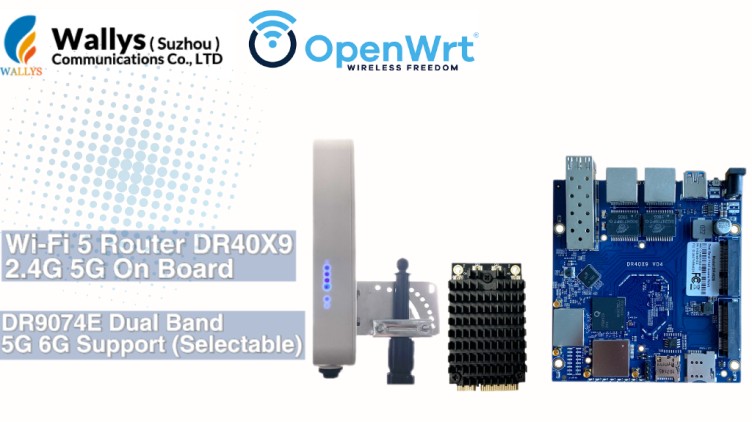QCN9074, QCN9274, QCN6274 – Wi-Fi 6E bands: 2.4 GHz, 5 GHz and 6 GHz – supports router management and control functions
QCN9074, QCN9274 and QCN6274 are a series of wireless communication chips produced by Qualcomm, each with different features and advantages. Here are their main differences and advantages:
[attach]92055[/attach]
QCN9074:
Wi-Fi 6 bands: 2.4 GHz and 5 GHz
Bluetooth band: Typically at 2.4 GHz
Application fields: QCN9074 is mainly used in Internet of Things (IoT) and embedded systems, such as smart homes, smart cities, industrial automation, etc.
Connectivity: Supports Wi-Fi 6 and Bluetooth 5.1, providing high-speed, low-power connection options.
Processing power: With a powerful multi-core CPU, it is suitable for applications that require high-performance processing.
Power Consumption: Designed for low power consumption, suitable for battery-powered devices.
single band-DR9074-6E(PN02.7)
QCN9274:
Wi-Fi 6E bands: 2.4 GHz, 5 GHz and 6 GHz
Bluetooth band: Typically at 2.4 GHz
Application fields: QCN9274 is usually used in high-end wireless routers and mid-to-high-end embedded systems, which require higher performance.
Connectivity: Supports Wi-Fi 6E (Wi-Fi 6 extended band), Bluetooth 5.2, and 2.5/5/10 GbE Ethernet.
Processing power: More powerful performance, suitable for applications that require higher computing power, such as when multiple users are connected at the same time.
Power consumption: relatively high, but performance is also higher.
WiFi7 card DR9274-6G
QCN6274:
Wi-Fi 6 bands: 2.4 GHz and 5 GHz
Bluetooth band: Typically at 2.4 GHz
Application fields: QCN6274 is mainly used in mid- to low-end embedded systems and mobile devices, such as smartphones, tablets, etc.
Connectivity: Supports Wi-Fi 6 and Bluetooth 5.1 for mobile devices and laptops.
Processing Power: Moderate performance for general needs of mobile devices.
Power Consumption: Designed to be energy efficient to help extend the battery life of mobile devices.
Note that specific frequency band support may vary by region and product configuration. Additionally, the 6 GHz band supported by the QCN9274 is part of Wi-Fi 6E, a relatively new standard designed to provide a wider spectrum range to reduce Wi-Fi congestion and improve performance.
Qualcomm wireless communication chips (such as QCN9074, QCN9274, QCN6274, etc.) used with routers can play a variety of roles in wireless network connections, depending on the performance and functionality of the chip, as well as the configuration and purpose of the router. Here are some possible uses for these chips paired with routers:
Provides high-speed wireless connectivity:
These chips support different Wi-Fi standards such as Wi-Fi 6 and Wi-Fi 6E, which can provide higher wireless data transmission speeds and better performance, allowing users to download and upload data faster.
Improve connection stability:
Qualcomm's wireless chips usually have advanced signal processing technology that can reduce wireless signal interference and packet loss, thereby improving the stability and reliability of the connection.
Supports multi-user connections:
These chips typically support multi-user multiple-input multiple-output (MU-MIMO) technology, allowing multiple devices to be connected simultaneously without slowing down each device, thus better meeting the needs of multi-device homes and offices.
Extended coverage:
By supporting more frequency bands and spectrum ranges, routers can provide wider coverage, ensuring that wireless signals can cover the entire home or office and reduce dead spots.
Support low-power devices:
Qualcomm's chips typically support low-power connectivity options for IoT devices and mobile devices that extend battery life.
Provide security features:
These chips often integrate advanced security features, including encryption and authentication functions, to ensure the security of wireless network connections.
Management and control functions:
Qualcomm's chips typically power router management and control functions, allowing users to configure network settings, monitor connections and perform remote management.
Wallys software technology advantages:
Wallys has 10 years of experience in software development and is very experienced in uboot, Linux, wifi protocol, wifi performance, OS and other systems. It mainly uses Qualcomm chips to develop important software such as drivers and kernels, and has the ability to modify and compile to meet customers' different wifi functional requirements. Meanwhile, it participates in openwrt organization and code development. wifi5 product DR40x9 has been officially supported by openwrt.
Hardware technology advantages:
We have a strong hardware design team, and experienced people know that the most difficult part of hardware design is RF circuit design, baseband, etc., while wallys team made 0 error to achieve signal integrity, such as frequency conversion of network card, from 2.4G to 900M, which is a technological breakthrough.
Clients: TIP,Facebook, Openwrt, etc
Email:sales@wallystech.com
WEB:https://www.wallystech.com/




































